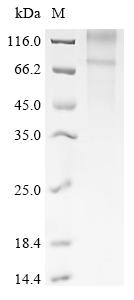Recombinant Human Frizzled-3 (FZD3)
CAT:
399-CSB-CF882067HU-01
Size:
100 µg
Price:
Ask
- Availability: 24/48H Stock Items & 2 to 6 Weeks non Stock Items.
- Dry Ice Shipment: No




Recombinant Human Frizzled-3 (FZD3)
- CAS Number: 9000-83-3
- Gene Name: FZD3
- UniProt: Q9NPG1
- Expression Region: 23-666aa
- Organism: Homo sapiens
- Target Sequence: HSLFSCEPITLRMCQDLPYNTTFMPNLLNHYDQQTAALAMEPFHPMVNLDCSRDFRPFLCALYAPICMEYGRVTLPCRRLCQRAYSECSKLMEMFGVPWPEDMECSRFPDCDEPYPRLVDLNLAGEPTEGAPVAVQRDYGFWCPRELKIDPDLGYSFLHVRDCSPPCPNMYFRREELSFARYFIGLISIICLSATLFTFLTFLIDVTRFRYPERPIIFYAVCYMMVSLIFFIGFLLEDRVACNASIPAQYKASTVTQGSHNKACTMLFMILYFFTMAGSVWWVILTITWFLAAVPKWGSEAIEKKALLFHASAWGIPGTLTIILLAMNKIEGDNISGVCFVGLYDVDALRYFVLAPLCLYVVVGVSLLLAGIISLNRVRIEIPLEKENQDKLVKFMIRIGVFSILYLVPLLVVIGCYFYEQAYRGIWETTWIQERCREYHIPCPYQVTQMSRPDLILFLMKYLMALIVGIPSVFWVGSKKTCFEWASFFHGRRKKEIVNESRQVLQEPDFAQSLLRDPNTPIIRKSRGTSTQGTSTHASSTQLAMVDDQRSKAGSIHSKVSSYHGSLHRSRDGRYTPCSYRGMEERLPHGSMSRLTDHSRHSSSHRLNEQSRHSSIRDLSNNPMTHITHGTSMNRVIEEDGTSA
- Tag: N-terminal 10xHis-tagged
- Source: in vitro E.coli expression system
- Field of Research: Signal Transduction
- Assay Type: CF Transmembrane Protein & In Stock Protein
- Relevance: Receptor for Wnt proteins. Most of frizzled receptors are coupled to the beta-catenin canonical signaling pathway, which leads to the activation of disheveled proteins, inhibition of GSK-3 kinase, nuclear accumulation of beta-catenin and activation of Wnt target genes. A second signaling pathway involving PKC and calcium fluxes has been seen for some family members, but it is not yet clear if it represents a distinct pathway or if it can be integrated in the canonical pathway, as PKC seems to be required for Wnt-mediated inactivation of GSK-3 kinase. Both pathways seem to involve interactions with G-proteins. Activation by Wnt5A stimulates PKC activity via a G-protein-dependent mechanism. Involved in transduction and intercellular transmission of polarity information during tissue morphogenesis and/or in differentiated tissues. Plays a role in controlling early axon growth and guidance processes necessary for the formation of a subset of central and peripheral major fiber tracts. Required for the development of major fiber tracts in the central nervous system, including: the anterior commissure, the corpus callosum, the thalamocortical, corticothalamic and nigrostriatal tracts, the corticospinal tract, the fasciculus retroflexus, the mammillothalamic tract, the medial lemniscus, and ascending fiber tracts from the spinal cord to the brain. In the peripheral nervous system, controls axon growth in distinct populations of cranial and spinal motor neurons, including the facial branchimotor nerve, the hypoglossal nerve, the phrenic nerve, and motor nerves innervating dorsal limbs. Involved in the migration of cranial neural crest cells. May also be implicated in the transmission of sensory information from the trunk and limbs to the brain. Controls commissural sensory axons guidance after midline crossing along the anterior-posterior aXIs in the developing spinal cord in a Wnt-dependent signaling pathway. Together with FZD6, is involved in the neural tube closure and plays a role in the regulation of the establishment of planar cell polarity (PCP), particularly in the orientation of asymmetric bundles of stereocilia on the apical faces of a subset of auditory and vestibular sensory cells located in the inner ear. Promotes neurogenesis by maintaining sympathetic neuroblasts within the cell cycle in a beta-catenin-dependent manner.
- Purity: Greater than 85% as determined by SDS-PAGE.
- Activity: Not Test
- Length: Full Length of Mature Protein
- Form: Liquid or Lyophilized powder
- Buffer: If the delivery form is liquid, the default storage buffer is Tris/PBS-based buffer, 5%-50% glycerol. If the delivery form is lyophilized powder, the buffer before lyophilization is Tris/PBS-based buffer, 6% Trehalose, pH 8.0.
- Reconstitution: We recommend that this vial be briefly centrifuged prior to opening to bring the contents to the bottom. Please reconstitute protein in deionized sterile water to a concentration of 0.1-1.0 mg/mL.We recommend to add 5-50% of glycerol (final concentration) and aliquot for long-term storage at -20℃/-80℃. Our default final concentration of glycerol is 50%. Customers could use it as reference.
- Molecular Weight: 75.3 kDa
- References & Citations: "Wnt proteins induce dishevelled phosphorylation via an LRP5/6- independent mechanism, irrespective of their ability to stabilize beta-catenin." Gonzalez-Sancho J.M., Brennan K.R., Castelo-Soccio L.A., Brown A.M. Mol Cell Biol 24:4757-4768 (2004)
- Storage Conditions: The shelf life is related to many factors, storage state, buffer ingredients, storage temperature and the stability of the protein itself. Generally, the shelf life of liquid form is 6 months at -20℃/-80℃. The shelf life of lyophilized form is 12 months at -20℃/-80℃.
